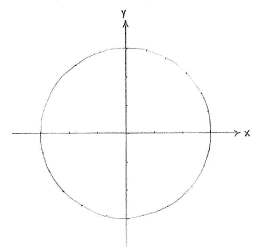Lösung 4.1:6a
Aus Online Mathematik Brückenkurs 1
(Unterschied zwischen Versionen)
K |
|||
| Zeile 1: | Zeile 1: | ||
If we write the equation as | If we write the equation as | ||
| + | {{Displayed math||<math>(x-0)^2 + (y-0)^2 = 9</math>}} | ||
| - | + | we can interpret the left-hand side as the square of the distance between the points (''x'',''y'') and (0,0). The whole equation says that the distance from a point (''x'',''y'') to the origin should be constant and equal to <math>\sqrt{9}=3\,</math>, which describes a circle with its centre at the origin and radius 3. | |
| - | we can interpret the left-hand side as the square of the distance between the points | ||
| - | <math>\left( x \right.,\left. y \right)</math> | ||
| - | and | ||
| - | <math>\left( 0 \right.,\left. 0 \right)</math>. | ||
| - | The whole equation says that the distance from a point ( | ||
| - | <math>\left( x \right.,\left. y \right)</math> | ||
| - | to the origin should be constant and equal to | ||
| - | <math>\sqrt{9}=3</math>, which describes a circle with its centre at the origin and radius | ||
| - | <math>\text{3}</math>. | ||
| - | |||
| - | |||
| - | |||
| - | {{NAVCONTENT_START}} | ||
<center> [[Image:4_1_6_a.gif]] </center> | <center> [[Image:4_1_6_a.gif]] </center> | ||
| - | |||
| - | |||
| - | {{NAVCONTENT_STOP}} | ||
Version vom 08:31, 8. Okt. 2008
If we write the equation as
we can interpret the left-hand side as the square of the distance between the points (x,y) and (0,0). The whole equation says that the distance from a point (x,y) to the origin should be constant and equal to \displaystyle \sqrt{9}=3\,, which describes a circle with its centre at the origin and radius 3.

